The full name of the lens written on its body is Nikon AF-S Nikkor 50mm 1: 1.8G SWM Aspherical, but it is commonly called Nikon 50 / 1.8G.
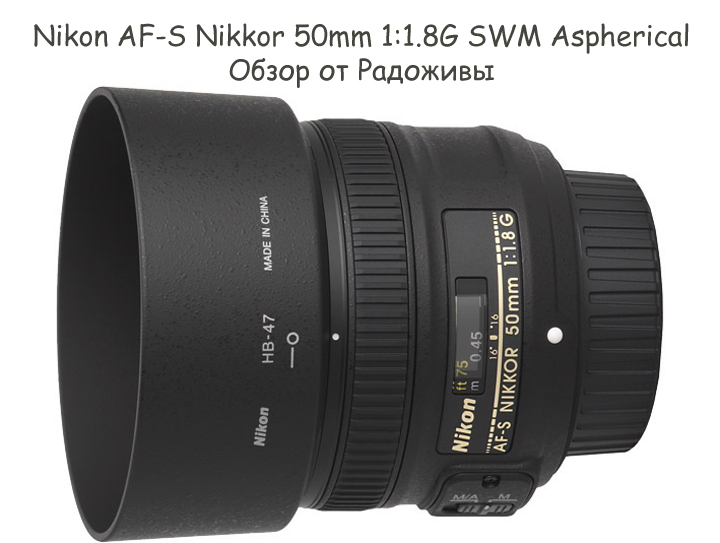
Nikon AF-S Nikkor 50mm 1: 1.8G SWM Aspherical with hood HB-47
Nikon 50 / 1.8G - it's fast fifty-degree autofocus lens from Nikon. 'Poltina' or 'fifty-kopeck' is the common name for a lens with a focal length of 50 mm. This focal length is very popular. On old cameras, XNUMX rubles were often installed as a standard lens, but nowadays, XNUMX rubles are attractive for a low price and excellent image quality.
The Nikon 50 / 1.8G lens is an upgrade to the legendary Nikon 50mm 1: 1.8D AF Nikkor from film cameras. The upgrade touched on the aperture control method, the optical circuit and the built-in focus motor. The new model is heavier and larger in size.
All Nikon 50 / 1.8 Autofocus Lenses
- Nikon 50mm 1: 1.8 AF Nikkor (first version, MKI) - the lens was produced only in Japan from 1986 to 1990. It is easy to distinguish by a window with a focusing distance and a narrow plastic focus ring. There are two subversions that are no different:
- MKI first subversion. Weighing 210 grams. It is easy to distinguish by the screw under the inscription '1: 1.8'. From September 1986 to March 1987. Serial numbers start at 2
- MKI second version. Weighing 165 grams. It is easy to distinguish by the absence of a screw under the inscription '1: 1.8'. From 1987 to 1990. Serial numbers start at 3.
- Nikon 50mm 1: 1.8 AF Nikkor (second version, MKII, also known as the 'N', or the 'NEW' version) - the lens was produced in Japan and China. The MK II version was produced from 1990 to 2001. There are three subversions that are no different:
- Nikon 50mm 1: 1.8D AF Nikkor (third version, MKIIIbetter known as 'D'-version) - the lens is available from 2002 to this day. All lenses are made in China.
- Nikon AF-S Nikkor 50mm 1: 1.8G SWM Aspherical (fourth version, MKIVbetter known as '1.8 G'-version or '1.8 AF-S' version) - the lens has been produced since 2011, all lenses are made in China.
- Nikon AF-S Nikkor 50mm 1: 1.8G SWM Aspherical Special Edition (fifth version, MKVbetter known as version 'Special Edition' or 'SE' or version for the camera with a retro design of the case Nikon Df) - the lens has been available since the fall of 2013. All lenses are made in China.
- Nikon Nikkor Z 50mm 1: 1.8 S, from summer 2018, lens for mirrorless cameras with Nikon Z mount... Diagram of 12 elements in 9 groups, 2 ED, 2 ASP.
Details on the lineup of fifty dollars from Nikon can be found in my article 'All Nikon autofocus fifty dollars'.
Main technical characteristics of the Nikon AF-S Nikkor 50mm 1: 1.8G SWM Aspherical
| Review Instance Name | Nikon AF-S Nikkor 50mm 1: 1.8G SWM Aspherical 2153108 |
| Basic properties |
|
| Front Filter Diameter | 58 mm, plastic thread for filters |
| Focal length | 50 mm, EGF for Nikon DX cameras is 75 mm |
| Zoom ratio | 1 X (this is a fixed lens, it does not have a zoom) |
| Designed by | for full-frame digital cameras |
| Number of aperture blades | 7 pieces |
| Tags | focusing distance in meters and feet, depth of field for F / 16, mark of bayonet mount and hood mount |
| Diaphragm | F / 1.8 to F / 16, without aperture ring. |
| MDF | 0.45 m, maximal magnification factor 1: 6.7 |
| The weight | 185 g |
| Optical design | 7 elements in 6 groups, 1 aspherical element (in the optical diagram, the aspherical element is shown in blue). This is Nikon's first fifty kopeck piece to use aspherical elements in its design. The Nikon AF-S Nikkor 50mm 1: 1.8G SWM Aspherical Special Edition has exactly the same optical design. The image is clickable. |
| Lens hood | Nikon HB-47 |
| Manufacturer country | MADE IN CHINA |
| Period | From April 2011 -> |
| Instructions | See |
| Price |
Nikon since available Nikon 50mm 1: 1.8D AF Nikkor, has not updated its set of fifty dollars for a long time. Before the Nikon 50 / 1.8G was released, there was only a choice between expensive f / 1.4 models and between the old non-motorized Nikon 50mm 1: 1.8D AF Nikkor... With the release of the new, relatively cheap Nikon 50 / 1.8G, users non-powered cameras got the opportunity to use aperture poltina without special investment.
Most importantly, what you need to know about the Nikon 50 / 1.8G:
1. The lens is also suitable for FX and DX cameras. That is, the lens can be used at full frame, for example, on full-frame FX cameras Nikon D600, D3s, D800, D750 etc., and on cropped cameras, for example, on Nikon D3300, D90, D5200 etc.
2. The lens has focus motor Silent Wave Motor (SWM), which means the lens can be used for everyone Nikon digital SLR cameras. The lens will automatically focus even on entry-level non-powered cameras: D40, D40x, D60, D3000, D3100, D3200, D3300, D5000, D5100, D5200, D5300, D5500.
3. The lens is marked “G”. This means the Nikon 50 / 1.8G has no aperture ring. The diaphragm is controlled only by the camera. This will prevent the lens from being used on older film cameras, or for example for macro with reversible adapter... This is not a disadvantage, but a tribute to the times. Almost all lenses now come without an aperture ring. You can read more about 'G' and 'Non-G' lenses here.
4. The diameter of the front filter is 58 mm, the same as that of Nikon 50mm f / 1.4G AF-S Nikkor. The lens is made of plastic, the assembly is good. Bayonet mount metal. All Nikon 50 / 1.8G lenses are manufactured in China.
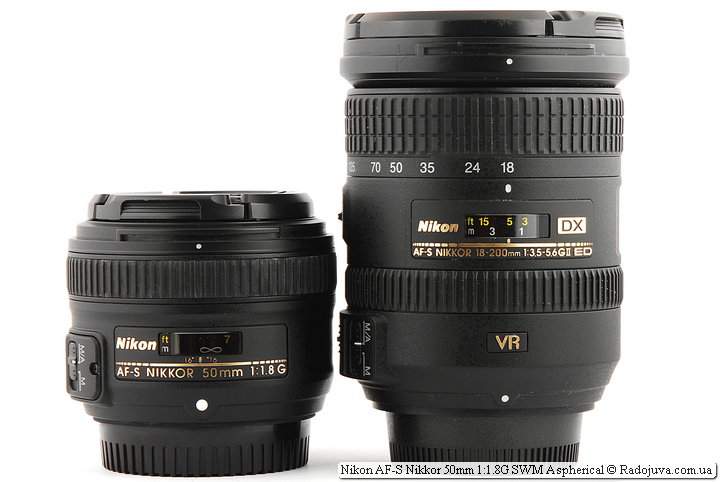
Nikon AF-S Nikkor 50mm 1: 1.8G SWM Aspherical fixed lens and universal lens Nikon DX AF-S Nikkor 18-200mm 1: 3.5-5.6GII ED SWM VR IF Aspherical
5. Focusing method. When focusing, the entire lens block moves. It is very important that the lens does not have internal focus. But at the same time, the method itself is made quite unusual, when focusing, the inner part of the lens moves, which is located in the middle of the pyramidal front frame. And that means that the trunk of the lens does not extend or rotate when focusing.
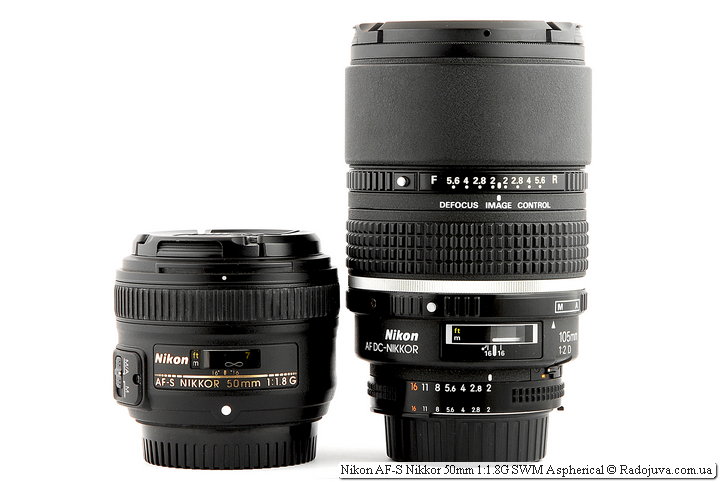
A fifty-fifty Nikon AF-S Nikkor 50mm 1: 1.8G SWM Aspherical and a true portrait lens Nikon AF DC-Nikkor 105mm 1: 2D
6. High speed focus. But always remember that the speed and accuracy of focusing is also associated with the camera itself and a number of other factors. The lens has focus distance scale. The distance is indicated in meters and feet. There is also a depth of field scale for F / 16.
7. On the lens housing can be found focus switch 'M / A - M'. In the 'M / A' position, auto focus works with constant manual focus priority. The 'M / A' mode is very convenient and useful - for manual focusing or focus correction, you do not need to additionally switch the lens to the 'M' mode.
8. The minimum focusing distance is 45 cm. The maximum ratio when magnified is 1: 6.7. You can’t shoot a macro with this lens, but at the same time it’s easy to shoot small objects.
9. When used on cropped cameras with Nikon DX, the viewing angle will be narrower than at full frame. It will appear that the viewing angle will be equivalent to the lens 75 mm full frame... This allows using the lens on cameras with a cropped matrix without any problems as a good portrait lens. But, please note that in fact Nikon 50 / 1.8G is just a universal fast prime lens, and it is not designed for a portrait. Anyway, the classic focal length for portraits starts at 80 mm.
10. Aperture. Yes, f / 1.8 is great aperture for shooting in low light. The lens can really be used in low light conditions. Well, if you want an even brighter lens, then you need to look at its brothers - Nikon 50mm f / 1.4G AF-S Nikkor and Nikon 50mm f / 1.4D AF Nikkor.
About the picture (photo quality)
The image is sharp already with F / 1.8. Maximum sharpness is achieved in the area of the aperture F / 5.6. The contrast is very good. The lens tolerates back and side light, sometimes it can catch hares. The bokeh of the lens is smooth and smooth, not as rough as that of Nikon 50mm 1: 1.8D AF Nikkor. When the aperture is closed, the lens makes of luminous objects 14 beam stars. On the open diaphragm, pronounced freezing. Chromatic aberrations quite strong up to F2.8, but this is typical of this kind of lenses. By the way, Nikon 50 / 1.8G for 2013 is Nikon's only fifty dollars using special aspherical element. In general, image quality is on top.
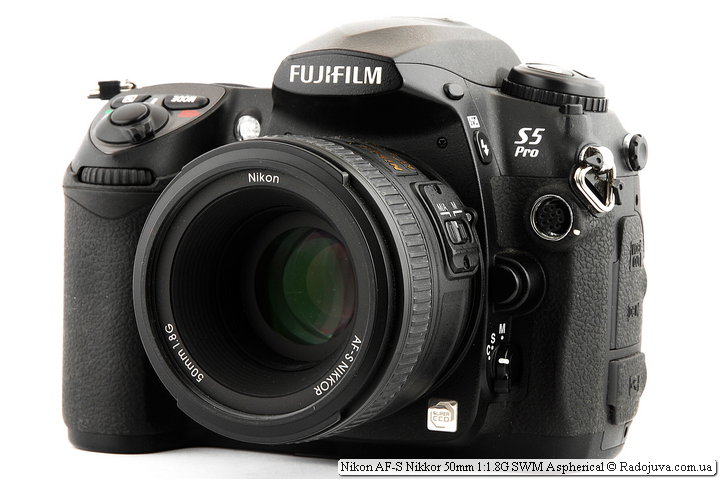
Nikon AF-S Nikkor 50mm 1: 1.8G SWM Aspherical on camera Fujifilm FinePix S5 Pro
Sample photos on Nikon D5100
All photos from Nikon D5100 without treatment. Reduced size and imprinted data with EXIF.
You will find many more examples in my post 'Fall 2020 on Nikon D40 and Nikkor 50 / 1.8G'
Sample photos on Nikon D700
In more detail about all-all 50-mm fast autofocus lenses Nikon can read here.
Sample photos on Fujifilm FinePix S5 Pro
Examples on the legendary camera Fujifilm FinePix S5 Pro (Nikon F mount) see here.
Video review
Video review available at this link, or embedded below:
Lens prices
Real prices for the lens in online stores can
- View on E-katalog
- View on Euroset
- View on Outlet
- View on Magazilla
- Look at Ozone
- View on Nadavi
- View in Svyaznoy
- View on M. Video
Conclusions
Nikon AF-S Nikkor 50mm 1: 1.8G SWM Aspherical is a good fast prime. Suitable as a budget portrait lens on DX cameras, it has good sharpness and color reproduction. I believe Nikon AF-S Nikkor 50mm 1: 1.8G SWM Aspherical the most optimal fifty dollars in the price \ quality section.
UPDATE: in 2016, a Chinese copy of this lens appeared at a cost 2-3 times lower than the original. See YONGNUO 50mm 1: 1.8 review (YN50mm F1.8N).
If there are any incomprehensible moments on the lens, ask me in the comments.
Comments on this post do not require registration. Anyone can leave a comment. Many different photographic equipment can be found on AliExpress.
Material prepared Arkady Shapoval. Training/Consultations | Youtube | Facebook | Instagram | Twitter | Telegram


























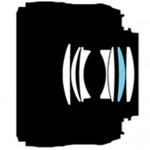

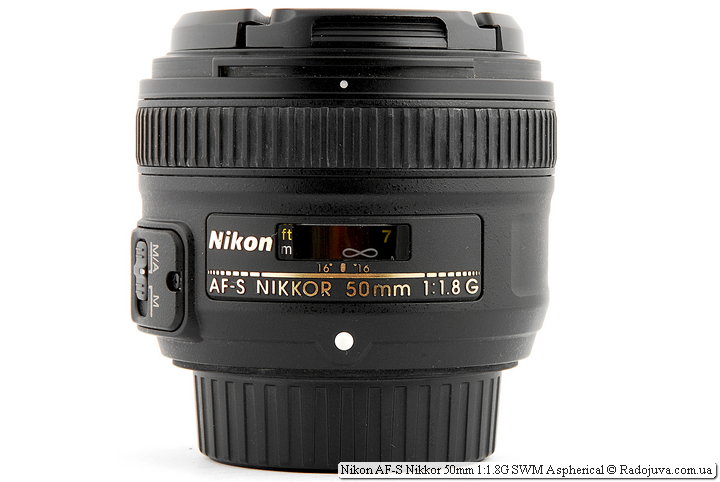
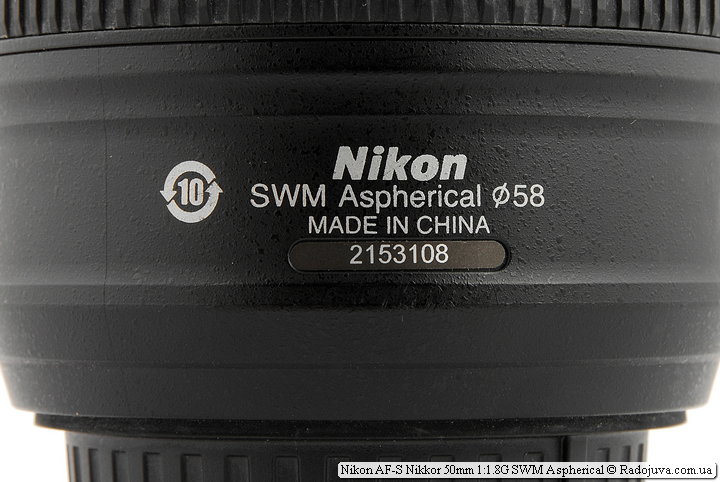
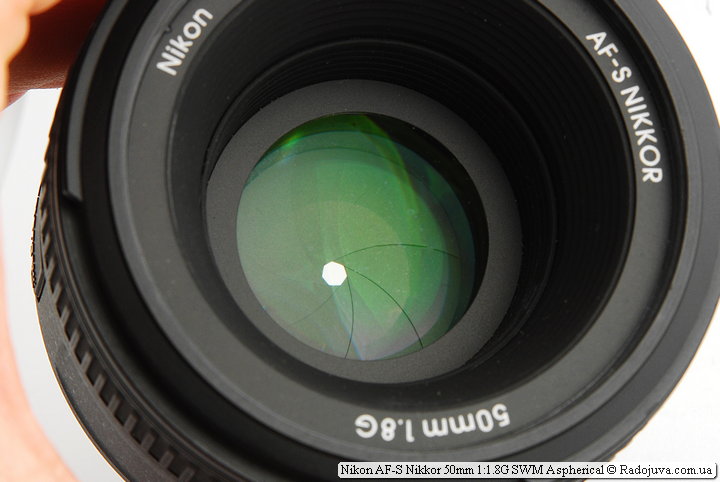
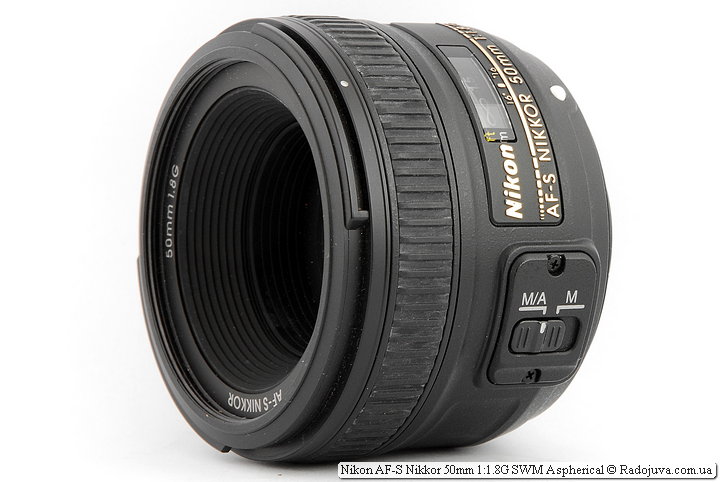


























Thanks for the help!!! Set focus on ael \ afl - and Hurray !!! everything works! Thanks again!
In order to be completely determined: Purchase goals: portrait shooting, bokeh, photos on walks, and generally ordinary shooting anywhere. Comparing 35 1.8 and 50mm 1.8g af-s, which lens, under equal conditions, are sharper and juicier in color?
For portraits, fifty dollars is better, both have rich colors, etc.
Arkady, hello, everything, the camera is purchased, thanks a lot for the advice. I listened and was very pleased. Now I have a Nikon D3100 with this fifty dollars, I’m very pleased, although I still haven’t really figured it out, but the picture is already pleasing to the eye! But I don’t understand a little about the diaphragm, I read how to set it. to get a clearer picture, but the camera has 2 functions, to get blurriness (background softening) and below there is another function, add objects to focus, also set the aperture and there and there f, in the picture, where the settings are, there is a girl Example, it is the same for me that I need to configure, I can’t understand both functions or one, they are different. And for example, I set the iris, iso? HOW TO MAKE AN EXTRACT 1/50, where to press that.
There are 4 great modes on the camera wheel.
A - the priority of diaphragm, what it is and what it is eaten with is described here - https://radojuva.com.ua/2012/02/diafragma/
S - shutter priority, this mode will help you get 1 \ 50s
ISO is adjusted through the camera menu; in automatic modes, manual ISO control is not available, it is automatically selected. About mode A, S - https://radojuva.com.ua/2011/03/rezhimy-fotoapparata-p-a-s-m/
And what is better to adjust for the quality and sharpness of the photo, what are the basic rules, I read from you, I realized that the main thing is aperture and shutter speed, and in more detail, where to click. I want the photo near to be clear, with blur in the distance, like you have with a ball, but how to do it, so that a few more objects are clear, I focus on more than one. As I understand it, these are the two main functions. about which I wrote, but if I want to take a photo with several objects clearly, it’s still blurry somewhere. I’m focusing, but it’s not coming out. here is an orange. clearly. and if a plate of food, not all food is clear. somewhere blur. but somewhere clearly. I don’t understand.
It is impossible to render multiple objects due to the linear hyperplane effect - https://radojuva.com.ua/2012/11/hyperfocalnoe-dof-main/
Thank you very much for not ignoring possible, at first glance, ridiculous questions)), but I really want to achieve the same high-quality photos that are presented on your site, especially since I bought this camera for nothing, I want to study!
I wish you creative success :)
Thank you!
“I’m wondering where the air that gets compressed from focusing goes when you screw on the lens protector.” - that is, you do not advise putting on a protective filter on this lens?
I advise you to put on the filter. Where the vodzuh goes - I don't know.
Thank you for your response
I read your reviews for 50 and 35 lenses, your recommendations ... but the question remains: for indoor shooting of fast moving small objects from 2 to 4 years old: which one would you recommend?
I would recommend a zoom, since it’s more difficult to crop with a fix, but if you need a fast aperture without a flash, then 35 1.8
Thanks for the advice
the main problem is autofocus - it costs kit 18-55, 35 1,8 will be faster than 50 1,8 and will the difference with the whale be more noticeable? - Are children too moving object?
Focusing speed from 50 1.8 will be faster, 35 1.8 a little slower, the difference with the whale will be very noticeable.
Forgot the most important thing - Nikon D5100
The camera does not play a role here.
Why? Crop or FF Isn't There a Difference?
Tell me, how on this lens to achieve sharpness of both the model and the background, for example, when portrait is waist-high or full-length?
As with any other, close the diaphragm.
And at night with a built-in flash?
Idem.
the main problem is autofocus - is kit 18-55, 35 1,8 will be faster than 50 1,8 and will the difference with the whale be more noticeable? - are children too mobile?
50 1.8 will be faster than whale, 35 slower for 50 1.8.
Thanks a lot for the cured headache ...
Good afternoon, the following interests.
By sharpness, which lens is better than 50 mm or 35 mm?
35 1.8
Thank you)
Arkady good morning, I’m tormented by one main question, where is it better to set the aperture on the camera, that there was good sharpness at the closest possible distance, it turns out to take a picture, I always go to the menu (not auto), there are two functions, with blurry, and add objects, and here and there, this F, I often photograph with the first function, select F 1.8, adjust the focus in the lens and photograph when I want the camera to focus on more than one object, select a function in the menu, add objects, and photograph, but with this function the screen in ph for some reason the device is dark. I also tried to photograph Christmas toys at home, but it was in poor lighting, it turned out super, the toy is clear and there is excellent blur, I think the flash is more likely, I took a piece of cake in the afternoon today, as it doesn’t take clarity and sharpness, what and it’s a problem, if not auto, to turn on these functions all the time, they are not saved if you turn off the camera. And there’s a little wheel there, + -. it’s also aperture setting, I don’t understand where to set it up correctly so that the pictures are clear and sharp, I read that someone gets clear pictures on F 4, but I still don’t understand exactly where to set this aperture. Many food photographers take great pictures on this lens or take a fifty-fifty g.4, they get clear pictures, for example, a piece of cake is clear and the cake itself is blurry in the distance, shoot in natural daylight, it turns out very beautifully, I understand that I need to learn, but I ask you for advice again.
How to take photos with a blurry background https://radojuva.com.ua/2012/01/dof-best-lens-photo/, it would also be nice to find out what kind of camera you have. There is only one advice - you need to learn and experiment.
I don’t need to supply the power for the D3200 Nikon 50mm f / 1.8G AF-S lens is the best option. Vesіllya young in the church, dyakoy for vіdpovіd
50 is very good for a portrait, but will not allow you to shoot in tight conditions, because 35t will be a good addition
Arkady. I have a Nikon D3100
Arkady, can you please give me some advice ?? I want to buy a SLR for the first time. I think NIKON D 5100 KIT 18-55 VR 55-200 VR. what do you think???
A good option, you will find useful information on the choice here - https://radojuva.com.ua/2013/01/what-camera-nikon-shoud-i-buy/
Arkady, please tell me which lens is better to take 50F 1.8G or 35F1.8G, I use D5100 18-105. And I’m also interested in the average price for them. Thank you in advance!
For what purpose? After all, these are different lenses, for one it will be better to fifty, for another - 35tk. I am not an online store to write prices here :)
Hello Arkady!
Prompt please,
What is the best way to take the Nikon D5100 18-105VR Kit or
Nikon D5100 Body (and Nikon 50mm f / 1.8G AF-S Nikkor)
I'm interested in portrait shooting and so on and everything else, I would like to deal with photos in the longest.
It will be difficult to capture everything else with one lens. If you have no experience at all, then I would not recommend taking 50 1.8G right away, and if you have experience, then fifty dollars will be an excellent lens.
Thanks for the answer! I understand that it is better to start the Nikon D5100 18-105VR Kit, tell me about the Extradigital UV 67mm setofilter as about its functions
I did not use the specified filter, but I believe that it will work as a normal protective filter, and its functions are quite general, such - https://radojuva.com.ua/2011/09/protect-foto-filter/
Arkady good evening, advise having a d5100 and a whale of 18-55 I often rent children at home in the room often lack of light I have to raise a lot of it, I can’t decide what to buy 50mm f / 1.8G AF-S or a flash of 700 will be limited help solve
I think the flash will be more useful, but the photos with the flash will be different.
Thank you for the answer. And what lens do you recommend for the k5100 and 700 for portraiture and home shooting?
Here's a fifty-kopeck piece - https://radojuva.com.ua/2012/02/obzor-nikon-50-mm-f-1-8-g-af-s/
Thanks for the answer, the lens is needed for portraiture. What is better to take? And about the price, I just wanted to find out, now I am abroad, the prices are a little cheaper. I wanted to compare and buy something. Thank you!
Which is better from fifty dollars for a portrait or even from lenses?
Thank you Arkady! Today I bought a 50mm AF-S. Yes, of course, soap is more significant compared to the 18-55mm whale. I rent mostly a child in an apartment))) I read the comments. You offered to take 35mm in the premises for young children, but for a long time I looked at different portraits and bokeh, and yet I decided to take 50mm. The difference in lenses (kit and 50mm) is incredible. And the fact that this lens on the D3100 goes like 75mm, I did not even notice))) it seems to me that the approximation is the same as on the 55mm whale.
This approach is because 50mm on the whale also gives 75 mm EGF :)
Another small question, everywhere they write to expose to infinity, what does this mean? On a 50mm lens, some kind of scale goes back and forth there is this infinity, do not tell me how to use it correctly? He focuses on infinity, what on a different magnitude, and what this means I do not understand.
Here is an example with the notation https://radojuva.com.ua/2012/11/hyperfocalnoe-dof-main/
Yes, which is better from fifty kopecks, thanks!
We will find about fifty dollars here - https://radojuva.com.ua/2012/12/all-50mm-lens-nikon-together/ For each task, a separate lens will be the best.
And maybe you will advise, preferably a combination of price and quality